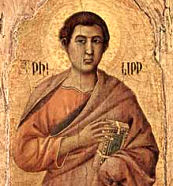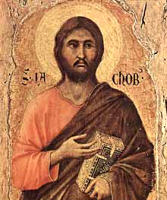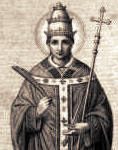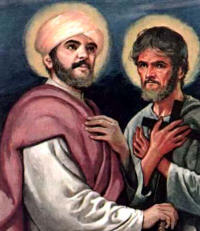Easter: May 3rd
Feast of Sts. Philip and James, apostles
Other Commemorations: Sts Alexander, Eventius and Theodulus, Martyrs (RM); St. Juvenal, Bishop (RM)
Free eBook:

|
| Free eBook: Liturgical Year 2023-2024, Vol. 4 |
» Enjoy our Liturgical Seasons series of e-books!
Today's Mass tells us that the example of the Apostles is the most certain and direct path to heaven. They suffered and were persecuted, but they placed their confidence in God and now they rejoice in heaven. We too must have confidence in God and not be troubled in our adversities. In our Father's house there are many mansions, and if we follow the way indicated by Him, Christ will come at the end of our life and take us to Himself.
Before the reform of the General Roman Calendar the Feast of Sts. Philip and James was celebrated on May 11 and the Finding of the Holy Cross and the commemoration of Sts. Alexander I, Eventius and Theodulus and St. Juvenal were celebrated. None of these feasts remain on the calendar in the United States.
St. Philip
 The Apostle Philip was one of Christ's first disciples, called soon after his Master's baptism in the Jordan. The fourth Gospel gives the following detail: "The next day Jesus was about to leave for Galilee, and He found Philip. And Jesus said to him: Follow Me. Now Philip was from Bethsaida, the town of Andrew and Peter. Philip found Nathanael, and said to him: We have found Him of whom Moses in the Law and the Prophets wrote, Jesus the Son of Joseph of Nazareth. And Nathanael said to him: Can anything good come out of Nazareth? Philip said to him: Come and see" (John 1:43ff).
The Apostle Philip was one of Christ's first disciples, called soon after his Master's baptism in the Jordan. The fourth Gospel gives the following detail: "The next day Jesus was about to leave for Galilee, and He found Philip. And Jesus said to him: Follow Me. Now Philip was from Bethsaida, the town of Andrew and Peter. Philip found Nathanael, and said to him: We have found Him of whom Moses in the Law and the Prophets wrote, Jesus the Son of Joseph of Nazareth. And Nathanael said to him: Can anything good come out of Nazareth? Philip said to him: Come and see" (John 1:43ff).
—The Church's Year of Grace, Pius Parsch
St. Philip is eighth in the Apostolic list of the Roman Canon; in the Synoptic Gospels he is named after the two groups of brother, Peter and Andrew, James and John (Matt 10:3; Mark 3:18; Luke 6:14). In St. John (I:43-44), we read that he was called after St. Peter to follow Jesus, and the Gospel adds he was of Bethsaida, as were Andrew and Peter. Philip introduced Nathaniel, who we know as the Apostle Bartholomew to Jesus (cf. St. Bartholomew). This same Gospel of St. John mentions Philip once again (John 14:9), in the passage, read at Mass, which serves also as the Antiphon of the Alleluia and for the Communion: "Philip, he that sees Me sees the Father also"; elsewhere (John 12:21) it tells us that certain Gentiles wishing to see Jesus had recourse to Philip, and in chapter 6 Jesus says to Philip, before the multiplication of the loaves, "Whence shall we buy bread, that these may eat?"
These little incidents, though they tell us nothing about St. Philip's inner life, show us that in the intimate companionship of the Apostles he played a distinct part. The Breviary story tells us that evangelized Phyrgia, and that, at Hierapolis, he was fastened to a cross and then stoned. It adds that his relics, with those of St. James, were taken to Rome and placed in the Basilica of the Twelve Apostles. This church was once one of the most venerated in Rome. It corresponds to the famous church of Byzantium called the Apostoleion or Church of the Apostles. St. Julius I (341-352_ erected it, Pelagius I (556-561) rebuilt it, and finally John III (561-574) dedicated it to the memory of all the Apostles, especially SS. Philip and James, whose relics were enshrined therein.
—Excerpted from The Year's Liturgy, Volume II, Fernand Cabrol, OSB
Patronage: Hatters; Luxembourg; pastry chefs; Uruguay
Symbols and Representation: basket; basket and Tau cross or letter Tau; two or three loaves and a cross; patriarchal cross and spear; knotted cross; broken idols; inverted cross; tall column; dragon; carpenter's square and cross; long staff and spear; tall cross and book.
Often Portrayed As: Elderly bearded man holding a basket of loaves and a cross which is often t-shaped; elderly man casting a devil from the idol of Mars; elderly man crucified on a tall cross; elderly man holding loaves and fishes; elderly man with a dragon nearby; elderly man with a loaf and book; elderly man with a snake nearby; loaves of bread; man baptizing the Ethiopian eunuch; man holding a book or scroll reading descendit ad inferna; with Saint Andrew.
St. James the Less
 St. James the Less, a brother of the Apostle Jude, was of Cana of Galilee. He is the author of one of the Catholic Epistles in the New Testament. He was favored by an appearance of the Risen Christ (I Cor. 15:7). After the dispersion of the Apostles he was made Bishop of Jerusalem. He was visited by St. Paul (Gal. 1:19). He spoke after Peter at the meeting of the Apostles (Acts 15:13). When he refused to deny the Divinity of Christ, the Jews cast him down from the terrace of the temple and clubbed him to death. The Breviary contains a very moving description of his death. "When he was ninety-six years old and had governed the Church for thirty years in a most holy manner, the Jews sought to stone him, then took him to the pinnacle of the temple and cast him off headlong. As he lay there half dead, with legs broken by the fall, he lifted his hands toward heaven and prayed to God for the salvation of his enemies, saying: Lord, forgive them for they know not what they do! While the apostle was still praying, a fuller struck his head a mortal blow." His relics now rest next to those of St. Philip in the church of the Holy Apostles in Rome, and their names are mentioned in the first list in the Canon of the Mass.
St. James the Less, a brother of the Apostle Jude, was of Cana of Galilee. He is the author of one of the Catholic Epistles in the New Testament. He was favored by an appearance of the Risen Christ (I Cor. 15:7). After the dispersion of the Apostles he was made Bishop of Jerusalem. He was visited by St. Paul (Gal. 1:19). He spoke after Peter at the meeting of the Apostles (Acts 15:13). When he refused to deny the Divinity of Christ, the Jews cast him down from the terrace of the temple and clubbed him to death. The Breviary contains a very moving description of his death. "When he was ninety-six years old and had governed the Church for thirty years in a most holy manner, the Jews sought to stone him, then took him to the pinnacle of the temple and cast him off headlong. As he lay there half dead, with legs broken by the fall, he lifted his hands toward heaven and prayed to God for the salvation of his enemies, saying: Lord, forgive them for they know not what they do! While the apostle was still praying, a fuller struck his head a mortal blow." His relics now rest next to those of St. Philip in the church of the Holy Apostles in Rome, and their names are mentioned in the first list in the Canon of the Mass.
—Excerpted from The Church's Year of Grace, Pius Parsch
The James here associated with St. Philip is St. James the Less, so-called to distinguish him from St. James the Greater, the brother of St. John, of whom we speak on his feast-day, July 25.
As to St. James the Less, his role, during the first years of Christianity, was far more important than St. Philip's. His position as one of the "brethren" or cousins of Our Lord was alone sufficient to make him an outstanding figure. Although certain incidents of his life-story are disputed, he is usually considered to have been the first Bishop of Jerusalem, the city wherein he was martyred. His mortifications and his ascetic life won for him the title of the Just.
St. Paul, who met him at Jerusalem, speaks of the apparition with which he was favored after Christ's Resurrection (1 Cor 15:7).
Among the Catholic Epistles there is one attributed to him. It is thought to be of a later date than the Epistles of St. Paul, and was probably written towards A.D. 60. The author seems to have had in mind those who wrongly claimed St. Paul's authority to teach that Faith without Good Works was sufficient for salvation. St. James speaks of certain practical matters and insists on the necessity of good works, especially those of charity.
The Mass is proper to the day. Its chief feature is Our Lord's speech to St. Philip: "Have I been so long a time with you and have you not known Me? Philip, he that sees Me sees the Father also." Several antiphons repeat this text. The Gospel of the day gives the passage (John 14:6-14). It is an extract from Christ's discourse at the Last Supper, wherein answering the questions of Thomas and Philip, He explains the bond uniting Him to His heavenly Father. Then Philip, who has not yet grasped the mystery of the Unity of the Father and the Son in the Divine Nature, asks in his simplicity: "Lord, show us the Father, and it is enough for us." Our Lord reiterates His teaching, "I am in the Father and the Father in Me," therefore "he that sees Me sees the Father also." Theologians appeal to these words to establish the doctrine, technically known as perichoresis in the Greek, and in the Latin as circumincessio, in virtue of which the Father is in the Son and the Son in the Father. Thus St. Philip's question leads to the Gospel teaching of the theology of the Blessed Trinity.
The Alleluia ad Communion antiphons, as we have said, repeat Christ's answer to this question, and we realize that the Roman cantors seized the opportunity of this feast to bring this doctrine into high relief.
—Excerpted from The Year's Liturgy, Volume II, Fernand Cabrol, OSB
Patronage: Apothecaries, druggists, dying people, fullers, hatmakers, hatters, milliners, pharmacists, Uruguay.
Symbols and Representation: Vertical saw; Fuller's club; windmill; halbert; three stones; loaf of bread.
Often portrayed as: man holding a book.
Highlights and Things to Do:
- Read the Letter of St. James.
- Read more about St. Philip and James:
- Catholic Encyclopedia: Philip and James
- Golden Legend: Philip and James
- Catholic Ireland
- CatholicSaints.info: St. James and CatholicSaints.info: St. Philip
- Saints Stories for All Ages
- Read Pope Benedict XVI's catechesis in 2006 on James the Lesser and Philip the Apostle.
- St. James is referred to as "the brother of Jesus", learn how to prove that Mary did not have any other children but remained ever a virgin.
- Relics of Sts. Philip and James are found in the Santi XII Apostoli church, dedicated to the 12 Apostles.
Sts. Alexander, Eventius and Theodulus
 Alexander governed the Church under the Emperor Hadrian. His name is inscribed in the Canon of the Mass. He was martyred at the same time as the priests Eventius and Theodulus, in 117, and their bodies rest in Rome, in the church of St. Sabina, where the Station is held on Ash Wednesday.
Alexander governed the Church under the Emperor Hadrian. His name is inscribed in the Canon of the Mass. He was martyred at the same time as the priests Eventius and Theodulus, in 117, and their bodies rest in Rome, in the church of St. Sabina, where the Station is held on Ash Wednesday.
—Saint Andrew Daily Missal
Symbols and Representation: Nails; stiletto; angel with torch; Often pictured with his chest pierced with nails or spikes.
Highlights and Things to Do:
- The relics of Saints Alexander, Theodulus and Eventius were first buried along the Via Nomentana in Rome, Italy. Later their relics were transferred to Santa Sabina which is the traditional Station Church for Ash Wednesday.
- As mentioned above, there is confusion and misunderstanding on the identity of these martyrs. Earlier accounts say mix Alexander as Pope Alexander I, and also say that the other two men were priests. The latest Roman Martyrology just states they were martyrs along the Via Nomentana.
St. Juvenal
 A priest and physician from the East, he immigrated to Narni, Italy, and was named first bishop of that See by Pope Damasus. Juvenal is reported to have saved Narni from destruction by invading Ligurians and Sarmatians when thousands of the invaders were drowned in a downpour reputedly brought on by his prayers. He was noted for his eloquent preaching, which converted many, and is the patron of Narni.
A priest and physician from the East, he immigrated to Narni, Italy, and was named first bishop of that See by Pope Damasus. Juvenal is reported to have saved Narni from destruction by invading Ligurians and Sarmatians when thousands of the invaders were drowned in a downpour reputedly brought on by his prayers. He was noted for his eloquent preaching, which converted many, and is the patron of Narni.
—Dictionary of Saints, John J. Delaney
Highlights and Things to Do:
- Again, not much is known about this saint. It has been said that he might be a martyr, but the historical records have not been able to support this.
- See CatholicSaints.info for more information.







